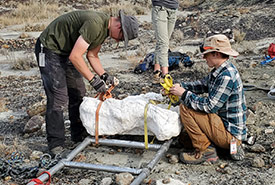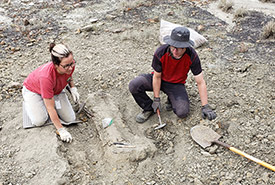More dino discoveries at Horseshoe Canyon

A large fossil is prepared for extraction (Photo courtesy François Therrien)
Paleontological work at Horseshoe Canyon in Alberta is ongoing, with the latest field season yielding more exciting dinosaur discoveries.
Located southwest of Drumheller, east of Calgary, Horseshoe Canyon is an iconic example of the Canadian Badlands. The Nodwell property on the canyon’s west side is owned and managed by the Nature Conservancy of Canada (NCC), while the east belongs to Kneehill County.
Leading this work is a team of paleontologists from the Royal Tyrell Museum, led by François Therrien, the museum’s curator of dinosaur paleoecology.
Full of bones after all
Unlike sites in the Drumheller Valley, Horseshoe Canyon was long not considered ripe for paleontology.
“For the longest time, we thought there were no fossils there, because we never found any — some petrified wood, but no bones,” explains Therrien.
It was believed that the rocks in Horseshoe Canyon, deposited a couple of million years later than those in Drumheller, might not have had the right conditions for fossil formation. But that all changed in 2020, when Nathan Hrushkin and his father, Dion, discovered an almost complete skeleton of a young hadrosaur (or “duck-billed dinosaur”) in the canyon.
“That was a watershed moment,” says Therrien. “We started spending more time there and started finding fossils everywhere in the canyon.”
Enjoying this story? Sign up for our newsletter!
More and more bones
Some of the fossils at Horseshoe Canyon have been reported by the canyon’s 200,000 or so yearly visitors. Others have been found by young participants of the museum’s Badlands Science Camp, while others have been identified by the museum’s own prospecting surveys.

Fossils are excavated at Horseshoe Canyon (Courtesy François Therrien)
Since 2020, scientists at the museum have made some intriguing discoveries, including a grouping of bones from an adult duck-billed dinosaur and part of the leg of a small meat-eating dinosaur, potentially a young tyrannosaur.
In 2023, a dig on the Kneehill County side of the canyon revealed the remains of an adult duck-billed dinosaur, in addition to a few vertebrae in the hillside.
Closing gaps in the record
These findings play a crucial role in closing gaps in paleontological knowledge, particularly regarding the period between 69 and 67 million years ago.
“We just keep coming back and spending more time there, and we keep finding more fossils,” says Therrien. “That’s really fun and encouraging, because it shows we may be able to finally learn about what was happening to dinosaurs during that time interval.”
Another facet of conservation
Therrien’s work at Horseshoe Canyon shows that conservation work can not only help protect the species of today, but also those of eons ago.
“If there were no protected sites like that, any kind of construction could alter the landscape and destroy these resources,” he says. “So, it’s great that NCC is interested in not only conserving the natural landscape there, but also preserving the paleontological resources it contains.”
Want to support conservation in the Canadian Badlands? Support NCC's Prairie Grasslands Action Plan!




